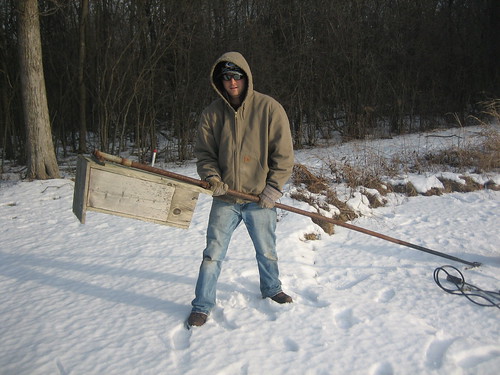From the Wild Side
From the Wild Side is a new, regular feature on our blog. Author Bob Retko has been on the staff at Lynden since 1966.
This winter the ice formation on most bodies of water in Wisconsin was painfully slow and unpredictable. The three inches required to safely hold a human came to Lynden’s ponds in early January, about a month later than average. It is the clear first ice that allows us easier access to clear out and store the sculpture garden’s two wood duck nest boxes.
If you have walked around the Big Lake you may have seen one weathered cedar nest box fixed to a pipe among the white cedars on the water’s edge at the east bay. The second is located across the road to the north in the much smaller Lily Pond. We haven’t been keeping records, but those two nest boxes have been in the same location for well over 20 years. Each spring they play a central role in the courtship and breeding of “woodies” at Lynden.
There is a good chance that you may see mallard ducklings throughout the spring and summer on the waters here. Since mallards are for the most part ground nesters, a mallard hen’s biggest concern is finding adequate ground cover to avoid the multitude of predators so that she can bring off a successful clutch of eggs. Should she be successful, she and her brood might stay on the open ponds all summer. Wood ducks, on the other hand, are cavity nesters and while they may face less of a threat from ground predators, the availability of suitable nest cavities may be a limiting factor. Wood ducks prefer to spend most of their time on wooded creeks and sloughs rather than on open water. As a result, you would be very lucky to see a more secretive wood duck hen with her brood at Lynden. Most wood duck broods hatch around Memorial Day and are taken by the hen to brushy waterways after a day or two.
If you are interested in erecting wood duck nest boxes to attract waterfowl, you need to commit to maintaining the boxes each year to improve the occupancy rate and nesting success. At Lynden, we have mounted our boxes on steel pipes over water. This greatly reduces the chances of predators such as squirrels, opossums and raccoons gaining access. When the ice forms in early winter, we pull the nest box and the pipe from the lake bottom, open the nest box and check for hatched eggs, and clean out the nest cavity. Removing the box in winter also prevents squirrels from using it to raise their young just prior to the arrival of the wood ducks in early April. Once cleaned, the nest box is stored. The boxes are filled with fresh wood shavings and reinstalled as the honeycombed old ice of winter recedes in the spring.
- Willy's blog
- Login to post comments



